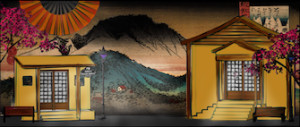I spent three anxious years yearning to attend a live performance of THE MIKADO when a Manhattan theatrical company announced that the classic operetta would be part of its 2015-16 program.
Then they cancelled.
One might be tempted to take a Snickersnee – defined as “a large knife” from Japan – to the entire company of the New York Gilbert & Sullivan Players, which as its name suggests produces G&S plays, and it reputedly does them with flair and expertise. A Snickersnee is wielded by Ko-Ko, the Lord High Executioner for the town of Tipitu whose role it is to literally execute his duties which he has yet to execute after his first year on the job. This dearth of executions in Tipitu worries the Japanese emperor – known as the Mikado – whose government investigates why Ko-Ko has neglected his duties. To avoid the same fate, Ko-Ko seeks out criminals who commit monstrous offenses like flirting, and he finds one in Nanki-Poo, a wandering minstrel who turns out to be the Mikado’s son in disguise.
I hoped to see the play in its entirety after watching the 1999 English film Topsy Turvy on television. The movie recounts how the making of THE MIKADO, in 1885, saved the collaboration of Sirs William S. Gilbert and Arthur Sullivan after Sir Arthur threatened to break up the team. Topsy Turvy is a mesmerizing film that features several songs from their plays – a half-dozen from THE MIKADO. The music and lyrics are so captivating that I had to see a stage production.
Pressure to avoid stereotyping Japanese culture led to the original cancellation, but the past year was well spent as the company adjusted THE MIKADO to respect cultural sensibilities while, as G&S company leaders write in their literature, “upholding the artistic integrity of the piece: its characters, storytelling, themes and most of all its universal satire of human nature and recurring societal and personal excesses.”
 The result is a vibrant, three-hour clever and engaging tale accompanied by its many classic show-stopping musical numbers. As it turned out, the play needed no Japanese costumes or yellow-cake makeup to entertain. Actors wore decidedly non-Asian-type clothes and did not disguise their race; many of the performers were white. The producers said in their literature that William S. Gilbert’s libretto (the pre-music play) required only minor revisions.
The result is a vibrant, three-hour clever and engaging tale accompanied by its many classic show-stopping musical numbers. As it turned out, the play needed no Japanese costumes or yellow-cake makeup to entertain. Actors wore decidedly non-Asian-type clothes and did not disguise their race; many of the performers were white. The producers said in their literature that William S. Gilbert’s libretto (the pre-music play) required only minor revisions.
More than 130 years after creating THE MIKADO, Gilbert and Sullivan sort of picked up a co-author for this company’s version. Director David Auxier wrote a short prologue depicting Gilbert (the playwright) and Sullivan (the composer) in London mulling their future together, listening to their producer’s pleas for a new opera, coping with actors’ demands and being shown a cabinet filled with Japanese memorabilia – until a scabbard-covered Japanese sword collapses from its spot on a mantelplace onto Gilbert’s head and knocks him unconscious, and in turn he dreams of a Japanese town called Titipu.
The prologue is stocked with in-jokes for audience members familiar with the play.
The New York company’s treatment could serve as a model for future performances elsewhere. As the villainous Katisha would say, THE MIKADO “has a fascination that few can resist.”
The first act is slow in spots partly because of bland-sounding tunes spaced between legendary numbers like “Behold the Lord High Executioner” and “Three Little Maids from School Are We.” This pattern had the effect of almost lulling a viewer to sleep and then jolting him awake with a captivating musical number. The second act was near perfect as it combined gripping plot twists with some of the most momentous songs in theater history.
Cutting the more lackluster songs would not have been unusual. Shortly before the show opened, Gilbert excised “A More Humane Mikado,” sparking protests from the cast that moved him to restore the song. Sullivan was roundly rebuked by critics for supposedly wasting his talents on these operettas when his time would be better spent composing serious music.
Otherwise, THE MIKADO lived up to its iconic reputation. Loved it and yearn to see it again. I would endure whatever obstacle course that New York or any other town might put up to reach the appointed theater. As Katisha would also say, “People come miles to see it.”
[Kaye Playhouse at Hunter College, 68th Street and Lexington Avenue, New York City] December 28, 2016-January 8, 2017; nygasp.org.
